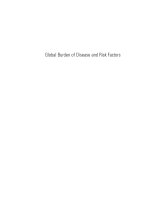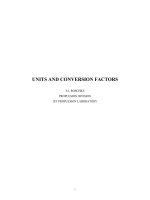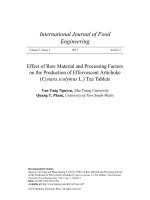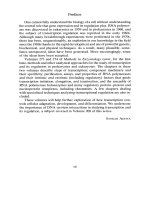Lansawood hazardous and harmful factors
Bạn đang xem bản rút gọn của tài liệu. Xem và tải ngay bản đầy đủ của tài liệu tại đây (508.33 KB, 53 trang )
The Language of Safety and Health Signs and Signals in Wood Industry
No. 134575 – LLP – 2007 – 1 – BG – Leonardo – LMP
HAZARDOUS AND
HARMFUL FACTORS IN
WOOD INDUSTRY
The Language of Safety and Health Signs and Signals in Wood Industry
No. 134575 – LLP – 2007 – 1 – BG – Leonardo – LMP
Main hazardous and harmful factors in Wood
Industry:
•Woodworking Machines;
•Wood Dust;
•Fire and Explosion;
•Noise;
• Vibrations;
• Manual Handling;
• Hazardous Chemical
Substances;
• Slips and Trips
The Language of Safety and Health Signs and Signals in Wood Industry
No. 134575 – LLP – 2007 – 1 – BG – Leonardo – LMP
1. Woodworking Machines
What is woodworking machinery?
spindle moulders; circular, crosscut and rip saws; radial arm saws;
band saws; jointers; planers; shapers; lathes; sanding machines;
boring and mortising machines; routers; tenoning machines, etc.
etc
The Language of Safety and Health Signs and Signals in Wood Industry
No. 134575 – LLP – 2007 – 1 – BG – Leonardo – LMP
What are the risks?
•Sharp unguarded parts;
•Rotating unguarded parts turning at high revolutions;
•The force exerted on a piece of wood by a rotating part causing
the machinist to be injured or knocked off balance;
•Unguarded moving parts, or moving without warning, or moving
unpredictably;
•Hand feeding without using a jig or push stick
The Language of Safety and Health Signs and Signals in Wood Industry
No. 134575 – LLP – 2007 – 1 – BG – Leonardo – LMP
What are the dangerous parts?
•nip points;
•rotating blades;
•rotating wheels;
•moving parts;
•movable (reciprocating) blades;
•pressing parts
The Language of Safety and Health Signs and Signals in Wood Industry
No. 134575 – LLP – 2007 – 1 – BG – Leonardo – LMP
Which jobs are affected?
Regardless of which job or machine, those carrying out the work
must have the skills, knowledge, training and experience, to allow
them to work safely in accordance with the manufacturer’s
instructions and they must be provided with machines that are
properly maintained.
The Language of Safety and Health Signs and Signals in Wood Industry
No. 134575 – LLP – 2007 – 1 – BG – Leonardo – LMP
How should hazardous machines be guarded?
•Stationary guards;
•Moving, non-interlocking guards;
•Interlocking guards
The Language of Safety and Health Signs and Signals in Wood Industry
No. 134575 – LLP – 2007 – 1 – BG – Leonardo – LMP
Stationary guards may be:
•fixed guards;
•distance guards;
•fence guards;
• adjustable guards;
• riving knives
The Language of Safety and Health Signs and Signals in Wood Industry
No. 134575 – LLP – 2007 – 1 – BG – Leonardo – LMP
Moving, non-interlocking guards may be:
•automated guards moved automatically by the machine;
•self-adjusting, moveable guards which adjust to accommodate the
material. These guards are opened at the beginning of the
operation by the passage of the material and return to the safe
position when the last of the material passes through the guard.
The Language of Safety and Health Signs and Signals in Wood Industry
No. 134575 – LLP – 2007 – 1 – BG – Leonardo – LMP
Interlocking guards may be:
•moving interlocking guards that contain movable parts and whose
movement is interconnected with the power or control system of
the machine;
•interlocking distance guards that do not completely enclose a
hazard, but prevent access by their distance from the hazard
The Language of Safety and Health Signs and Signals in Wood Industry
No. 134575 – LLP – 2007 – 1 – BG – Leonardo – LMP
Guard construction
Guards can be made from durable material suitable for the purpose
and may be: solid sheet metal, metal rod, perforated or mesh
material, acrylic or polycarbonate, stainless steel, rubber or timber
The Language of Safety and Health Signs and Signals in Wood Industry
No. 134575 – LLP – 2007 – 1 – BG – Leonardo – LMP
Other forms of safety devices
•Trip devices;
•Electro-sensitive safety systems;
•Pressure sensitive systems
The Language of Safety and Health Signs and Signals in Wood Industry
No. 134575 – LLP – 2007 – 1 – BG – Leonardo – LMP
Basic Safety Rules for People Operating
Woodworking Machines
•Only authorised people who have been properly trained and
assessed as competent, should operate or work at woodworking
machines;
•Safe operating procedures must be provided and used in respect of
each machine;
•Appropriate hearing protection, eye shields and dust masks should
be worn when required;
The Language of Safety and Health Signs and Signals in Wood Industry
No. 134575 – LLP – 2007 – 1 – BG – Leonardo – LMP
•Machines must be switched OFF when not in use and ISOLATED
before any repair, cleaning or maintenance is done;
•The machinist’s attention must not be distracted while work is in
progress;
•Don’t operate machinery if fatigued or otherwise unfit for the task
at hand;
The Language of Safety and Health Signs and Signals in Wood Industry
No. 134575 – LLP – 2007 – 1 – BG – Leonardo – LMP
•If mechanical feeding is not available, use push sticks or avoid the
need for hands to be near cutters or saw blades;
•Wear clothing that will not catch in cutters or other moving parts;
•Don’t have long hair free or wear jewellery that might get
entangled in the machinery.
The Language of Safety and Health Signs and Signals in Wood Industry
No. 134575 – LLP – 2007 – 1 – BG – Leonardo – LMP
2. Wood Dust
Wood dust consists of tiny particles of wood produced during the
processing and handling of wood, particleboards, fibreboards and
other composite boards.
The Language of Safety and Health Signs and Signals in Wood Industry
No. 134575 – LLP – 2007 – 1 – BG – Leonardo – LMP
Activities likely to produce high dust levels include:
•machining operations;
•sanding;
•using compressed airlines;
•hand assembly of machined/sanded components;
•any operations involving composite boards;
•the bagging of dust from dust extraction systems;
•factory cleaning
The Language of Safety and Health Signs and Signals in Wood Industry
No. 134575 – LLP – 2007 – 1 – BG – Leonardo – LMP
What are the hazards?
Health hazards include:
•skin disorders;
•obstruction in the nose and rhinitis;
•asthma;
•a rare type of nasal cancer
Maximum exposure limit (MEL) - 5 mg/m3 (8-hour time-weighted
average).
The Language of Safety and Health Signs and Signals in Wood Industry
No. 134575 – LLP – 2007 – 1 – BG – Leonardo – LMP
Fire/explosion hazard - wood dust fires and explosions;
Safety hazard - wood dust on the floor can cause tripping or
slipping. Vision can be impaired by airborne chips and dust
generated during machining and sanding operations
The Language of Safety and Health Signs and Signals in Wood Industry
No. 134575 – LLP – 2007 – 1 – BG – Leonardo – LMP
Basic Safety Rules
•Make sure the personal protective equipment is suitable and kept
in good order;
•Launder overalls and aprons regularly;
•Provide good washing facilities with hot and cold water, soap and
towels and encourage a high standard of personal hygiene;
The Language of Safety and Health Signs and Signals in Wood Industry
No. 134575 – LLP – 2007 – 1 – BG – Leonardo – LMP
•Provide vacuum cleaning equipment to remove dust from
clothing;
•Make sure workers are adequately informed, instructed, trained
and supervised;
•Check that the design and installation of dust control equipment
incorporates explosion precautions;
•Keep floors free and clear from wood chips and dust. Pay
particular attention to areas around machines and on or near
heating units;
The Language of Safety and Health Signs and Signals in Wood Industry
No. 134575 – LLP – 2007 – 1 – BG – Leonardo – LMP
•Clean inside walls, ceilings, ledges and other surfaces of
workrooms regularly to prevent dust accumulating;
•Do not use compressed airlines or hand brushing as these will
create dust clouds and redistribute the dust.
The Language of Safety and Health Signs and Signals in Wood Industry
No. 134575 – LLP – 2007 – 1 – BG – Leonardo – LMP
3. Fire and Explosion
Woodworking facilities are prone to fires and explosions for the
following reasons:
•Large quantities of fuel in the form of wood and wood products,
sawdust, and flammable materials such as paints, oil finishes,
adhesives, solvents, etc.;
•Ignition sources, such as potentially faulty electrical wiring,
cutting and welding operations, sparking tools. There is also the
potential for static electrical discharges.
The Language of Safety and Health Signs and Signals in Wood Industry
No. 134575 – LLP – 2007 – 1 – BG – Leonardo – LMP
Basic Safety Rules
•Ensure the proper use and storage of flammable materials, such as
paints, finishes, adhesives, and solvents;
•Segregate tasks particularly prone to fire and explosion hazards,
such as spray painting and welding;
•Train employees to recognize, avoid, and correct potentially
hazardous conditions and behaviors;
The Language of Safety and Health Signs and Signals in Wood Industry
No. 134575 – LLP – 2007 – 1 – BG – Leonardo – LMP
•Train employees so that they are acquainted with the special
equipment and aspects of building design related to dealing with
fires and explosions;
•Control ignition sources;
•Never permit blow-down of accumulated dust with compressed
air;









